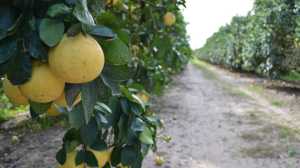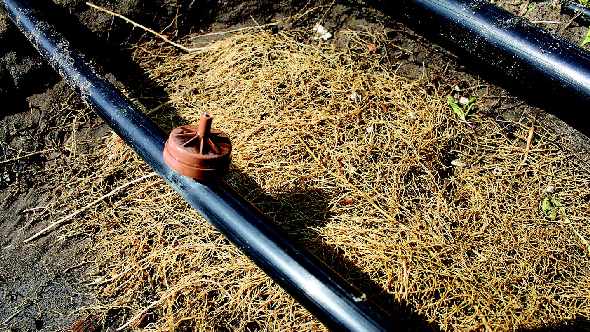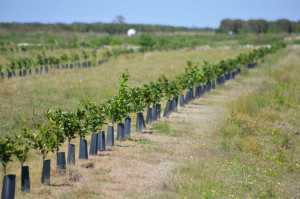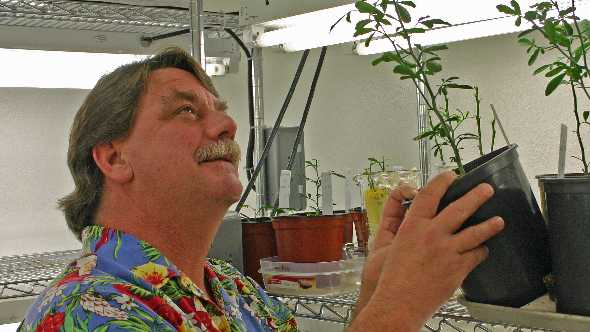10 Reasons Why Florida Citrus Will Survive HLB
On Oct. 25, 2005, USDA confirmed 404 HLB-positive trees from 268 residential and commercial grove locations in Florida. For many, this date marks the “official” beginning of the disease’s march across Florida even though it had been detected earlier.
That survival will be driven by things growers already have learned about living with HLB and the promise of new research breakthroughs down the road. Despite declining production, these efforts are helping.
Here’s a look at 10 reasons why Florida citrus will survive.
-
Aggressive Psyllid Control

Photo by Michael Rogers
What is the current threshold for Asian citrus psyllids in your grove? Zero; if you are serious about mitigating the spread of HLB. Keeping psyllid populations low is where growers can have the most impact on this disease. And, many are by participating in CHMAs to control the pest over larger areas.
According to CHMA coordinator Brandon Page, it is hard to pinpoint the exact acreage participating because it varies from group to group, but overall activity has been strong. “In active, well-managed CHMAs, we can get 70% to 80% participation most of the time,” he says.
“The bottom line is the higher the CHMA participation, the lower the psyllid populations.”
 2. Enhanced Tree Health
2. Enhanced Tree Health
In 2009, Florida Grower® magazine featured the pioneering work of Maury Boyd and his so called “cocktail” of foliar nutrients aimed at keeping trees healthy and productive in the face of HLB. At the time, his method was controversial because HLB-infected tree removal was still the mantra of the day. But, for Boyd and other growers, it was becoming clear the disease had spread too far, too fast to make tree removal a viable solution.
Since that time, growers have utilized many different foliar nutrition programs to promote tree health and longevity as HLB spreads. The practice has become standard to help trees bounce back from stress. Boyd reports his now famous grove in Felda remains productive after years of his nutrition regimen.

Photo by Arnold Schumann, UF/IFAS
3. Focus On Roots & Shoots
After growers learned the importance of foliar nutrition and tree health, there has been a growing awareness of the importance of root health when it comes to HLB. It was learned that as much as 30% to 50% of root density is lost to the disease before symptoms above ground even appear.
Jim Graham, a soil microbiologist with UF/IFAS, was on the cutting edge of knowledge that soil and irrigation water bicarbonates might be negatively impacting root health. His research has encouraged many growers to acidify their soil and irrigation water to lower bicarbonate levels. While it takes a couple of seasons to correct these problems, growers are seeing improved tree health where treatments are occurring.
In addition, some growers are attempting to balance the roots with the shoots with hedging and topping, or as Graham calls it, giving the trees a “haircut.”
Growers also are “spoon feeding” fertilizer to trees to allow roots to more effectively capture nutrients being applied.

Photo courtesy of UF/IFAS
4. New Varieties
There are literally thousands of varieties and rootstocks under evaluation and development by UF/IFAS and USDA. Some of these like Sugar Belle have shown greater tolerance to HLB than the old industry standards.
To advance the speed at which this massive amount of material is evaluated, the New Varieties Development & Management Corp. has deployed its FAST TRACK program to hopefully bring these promising varieties to growers soone
 5. Massive Research Effort
5. Massive Research Effort
There are few examples in crop history where so much research has been thrown at a crop problem.
“There are probably many instances where diseases or pests move into an agricultural arena and have significant impacts on the crop system in a regional manner,” says Harold Browning, COO of the Citrus Research and Development Foundation. “However, far fewer are the cases where a research response has accompanied the introduction of a new pest or disease, and I would place the Florida grower response to HLB as one of the most significant responses in recent history.”
According to Browning, early research focused on the interaction between the pathogen, vector, and tree. Much has been learned in this area and it is now easier for science to focus on interventions.
“Looking forward, the pursuit of interventions to reduce Asian citrus psyllid populations, reduce CLas populations in infected trees, and promote optimal tree health in the presence of HLB are becoming more focused,” he says. “While there remain a number of promising avenues for intervention, these are being separated based on their likelihood of impact, time to delivery, costs, and other parameters.”

Photo by Frank Giles
6. New Plantings
Growers are planting trees again in many areas and that is just as important to finding solutions to HLB. Without trees producing oranges, prices go up and consumption falls. In fact, we need to plant 3.1 million trees per year to meet processor demand.
One of those farms is Duda Citrus Division, which recently completed a nearly 3,000-acre expansion. Why? They believe new production practices and rootstocks will allow them to bring young trees into profitable production.
“With what we are doing with our production approach, I feel confident we can make a go of this deal,” says Rob Atchley, Duda Citrus general manager. “We have blocks still viable after seven years, so I have every reason to believe we can get 15 years or even more out of these plantings.”

Erik Mirkov inspects trees at his lab.
Photo courtesy of Texas A&M
7. GMO Trees?
In April 2015, Florida Grower magazine featured the prospect of how a genetically modified (GMO) tree could be a game changer in the fight against HLB.
Southern Gardens Citrus, in cooperation with scientists from Texas A&M, are developing a tree with a gene from spinach that is showing tolerance to the disease. Since the publication, EPA has granted an experimental use permit of the trait, which authorizes large-scale tests of these citrus plants. EPA also has concluded that residues of the spinach protein in the citrus are safe for the public.
Growers appreciate the PR challenge a GMO tree could present, but it ultimately may prove to be the silver bullet the industry needs.

Photo by Frank Giles
8. Grower Tenacity
Citrus growers can be a stubborn lot, but in a battle with the likes of HLB, that is a welcome trait. Most growers have entirely revamped their production systems incorporating many of the items featured in this story to hang on while science catches up to the problem.
In addition, they are sharing information with one another in unprecedented ways.
Growers are riding their groves with one another looking at what worked or didn’t in their approaches. Everyone appreciates its an “all-in” effort to win the HLB fight.
 9. Political Will & Funding
9. Political Will & Funding
Between growers, state, and federal funds, more than $200 million has been directed toward HLB research and support programs. In addition, the 2014 Florida Grower Citrus Achievement AwardSM winner Mike Sparks, executive vice president and CEO of Florida Citrus Mutual, helped pull off a huge political win for the industry by working to secure federal funds to fight the problem. After nearly four years of political negotiations, the funding came as part of the 2014 Farm Bill and directed mandatory spending of $125 million on citrus research over the next five years.
“We put our faith in research to find long- and near-term solutions to HLB,” Sparks says. “We are all in for dedicated, significant, and long-term funding.”
10. It’s Our Signature Crop
Citrus is Florida’s signature crop. It has been planted here since the 1500s and helps define the state’s very identity. Growers, researchers, and all others who make a living and love citrus are not going out without one hell of a fight against HLB.
We will win.

Photo by Frank Giles





